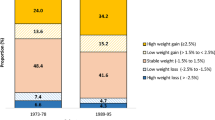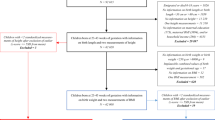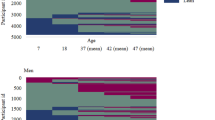Abstract
Objective:
There is a lack of comprehensive understanding about patterns of weight change from pregnancy to childbirth and beyond. We describe the trajectory of weight change pattern from pre-pregnancy to 6 months postpartum and examine demographical and perinatal variables that predict the weight change using the latent growth model (LGM).
Design and subjects:
This study used a longitudinal design. The study participants were 120 women whose body weights were measured at eight time points.
Results:
The adjusted mean pre-pregnancy weight was 52.57 kg. When the weight growth rate for 10–13 weeks of pregnancy and pre-pregnancy weight was set to 1, the body-weight change rate was 2.20 during the second trimester, 2.14 during the third trimester, –2.90 during the period from the third trimester to 2–3 weeks postpartum, –0.08 during the period from 2–3 weeks to 4–5 weeks postpartum, –0.37 during the period from 4–5 weeks to 11–12 weeks postpartum, and –0.65 during the period from 11–12 weeks to 24–25 weeks postpartum. On average, body weight increased 26.54% (13.95 kg) from pre-pregnancy to 36–39 weeks of pregnancy and body weight remained 6.26% (3.29 kg) higher at 24–25 weeks postpartum compare with pre-pregnancy. In terms of factors related to body weight, age was positively associated with pre-pregnancy body weight. Parity had a negative effect on the change of body weight. Women who had an increased change rate in body weight had higher newborn birth weights.
Conclusions:
We found that weight change from pregnancy to postpartum followed a pattern that could be specified using the LGM approach. The women retained more than 6% of weight at 6 months postpartum compared with their pre-pregnancy weight.
This is a preview of subscription content, access via your institution
Access options
Subscribe to this journal
Receive 12 print issues and online access
$259.00 per year
only $21.58 per issue
Buy this article
- Purchase on Springer Link
- Instant access to full article PDF
Prices may be subject to local taxes which are calculated during checkout


Similar content being viewed by others

References
World Health Organization. Obesity and overweight. http://www.who.int/mediacentre/factsheets/fs311/en 2006.
Weight Control Information Network. Statistics related to overweight and obesity. http://win.niddk.nih.gov/publications/PDFs/stat904z.pdf. 2007.
Chien LY, Liou YM, Chen JJ . Association between indices of obesity and fasting hyperglycemia in Taiwan. Int J Obes Relat Metab Disord 2004; 28: 690–696.
Boddy LM, Hackett AF, Stratton G . Changes in BMI and prevalence of obesity and overweight in children in Liverpool, 1998-2006. Perspect Public Health 2009; 129: 127–131.
Czemichow S, Vergnaud AC, Maillard-Teyssier L, Peneau S, Bertrais S, Mejean C et al. Trends in the prevalence of obesity in employed adults in central western France: A population-based study, 1995-2005. Prev Med 2009; 48: 262–266.
Walker LO . Managing excessive weight gain during pregnancy and the postpartum period. J Obstet Gynecol Neonatal Nurs 2007; 36: 490–500.
Siega-riz AM, Evenson KR, Dole N . Pregnancy-related weight gain-a link to obesity? Nutr Rev 2004; 62: 105–111.
Linné Y, Röeener S . Interrelationships between weight development and weight retention in subsequent pregnancies: The SPAWN study. Acta Obstet Gynecol Scand 2004; 82: 318–325.
Linné Y, Dye L, Barkeling B, Röeener S . Weight development over time in parous women-The SPAWN study-15 year follow-up. Int J Obes 2003; 27: 1516–1522.
Linné Y, Dye L, Barkeling B, Röeener S . Long-term weight development in women: a 15-year follow up of the effects of pregnancy. Obes Res 2004; 12: 1166–1178.
Linné Y, Neovius M . Identification of women at risk of adverse weight development following pregnancy. Int J Obes 2006; 30: 1234–1239.
Rooney BL, Schauberger CW, Mathiason MA . Impact of perinatal weight change on long-term obesity and obesity related illness. Obstet Gynecol 2005; 106: 1349–1356.
Nohr EA, Vaeth M, Baker JL, Sorensen TI, Olsen J, Rasmussen KM . Pregnancy outcomes related to gestational weight gain in women defined by their body mass index, parity, height, and smoking status. Am J Clin Nutr 2009; 90: 1288–1294.
Arendas K, Qiu Q, Gruslin A . Obesity in pregnancy: Pre-conceptional to postpartum consequences. JOGC 2008; 30: 477–488.
Guelinckx I, Devlieger R, Beckers K, Vansant G . Maternal obesity: pregnancy complications, gestational weight gain and nutrition. Obes Rev 2008; 9: 140–150.
Saldana TM, Siega-Riz AM, Adair LS, Suchindran C . The relationship between pregnancy weight gain and glucose tolerance status among black and white women in central North Carolina. Am J Obstet Gynecol 2006; 195: 1629–1635.
Walker LO . Predicators of weight gain at 6 and 18 months after childbirth: a pilot study. J Obstet Gynecol Neonatal Nurs 1996; 25: 38–48.
Soltani H, Fraser RB . A longitudinal study of maternal anthropometric changes in normal weight, over weight and obese women during pregnancy and postpartum. Br J Nutr 2000; 84: 95–101.
Villamor E, Cnattingius S . Interpregnancy weight change and risk of adverse pregnancy outcomes: a population-based study. Lancet 2006; 368: 1164–1170.
Institute of Medicine. Weight Gain During Pregnancy: Reexamining the Guidelines. National Academies Press: Washington DC, 2009.
Taiwan Department of Health. Maternal health handbook. http://www.bhp.doh.gov.tw/BHPnet/Portal/file/ThemeULFile/200904290238200193/%e5%ad%95%e5%a9%a6%e5%81%a5%e5%ba%b7%e6%89%8b%e5%86%8a_%e8%8b%b1%e6%96%87%e7%89%881.pdf. 2008.
Kleinman KP, Oken E, Radesky JS, Rich-Edwards JW, Peterson KE, Gillman MW . How should gestational weight gain be assed? A comparison, area under the weight gain curve. Int J Epidemiol 2007; 36: 1275–1286.
Maria GK, Benício HDA, Velásquez-Meléndez G, Valente JG, Struchiner CJ . Gestational weight gain and prepregnancy weight influence postpartum weight retention in a cohort of Brazilian women. J Nutr 2004; 134: 661–666.
Saldana TM, Siega-Riz AM, Adair LS, Suchindran C . The relationship between pregnancy weight gain and glucose tolerance status among black and white women in central North Carolina. Am J Obstet Gynecol 2006; 195: 1629–1635.
Huang TT, Dai F T . Weight retention predictors for Taiwan women at six-month postpartum. J Nurs Res 2007; 15: 11–20.
Core S, Brown DM, West DS . The role of postpartum weight retention in obesity among women: a review of the evidence. Ann Behav Med 2003; 26: 149–159.
Cohen J . Statistical Power Analysis for the Behavioral Science. Lawrence Erlbaum Associates: Hillsdale, New Jersey, 1988.
Duncan TE, Duncan SC, Strycker LA, Li F, Alpert A . An Introduction to Latent Variable Growth Curve Modeling: Concepts, Issues, and Applications. Mahwah, NJ: Erlbaum, 1999.
Browne MW, Cudeck R . Alternative ways of assessing model fit. In K. Bollen A, Long JS (eds). Testing Structural Equation Models. Sage: Newbury Park, CA, 1993. pp. 136–162.
Baker JL, Gamborg M, Heitmann BL, Lissner L, Sørensen TI, Rasmussen KM . Breastfeeding reduces postpartum weight retention. Am J Clin Nurs 2008; 88: 1543–1551.
Olson CM, Strawderman MS, Hinton PS, Pearson TA . Gestational weight gain and postpartum behaviors associated with weight change from early pregnancy to 1 year postpartum. Int J Obes Relat Metab Disord 2003; 27: 117–127.
Scholl TO, Hediger ML, Schall JI, Ances IG, Smith WK . Gestational weight gain, pregnancy outcome, and postpartum weight retention. Obstet Gynecol 1995; 86: 423–427.
Kac G, Benício MHDA, Velásquez-Meléndz G, Valente JG, Struchiner CJ . Breastfeeding and postpartum weight retention in a cohort of Brazilian women. Am J Clin Nutr 2004; 79: 487–493.
Helms E, Coulson CC, Galvin SL . Trends in weight gain during pregnancy: a population study across 16 years in North Carolina. Am J Obstet Gynecol 2006; 194: e32–e34.
Walker LO, Sterling BS, Timmerman GM . Retention of pregnancy-related weight in the early postpartum period: implications for women's health services. J Obstet Gynecol Neonatal Nurs 2005; 34: 418–427.
To WWK, Cheung W . The relationship between weight gain in pregnancy, birth-weight and postpartum weight retention. Aust N Z J Obstet Gynaecol 1998; 38: 176–179.
Kiel DW, Dodson EA, Artal R, Boehmer TK, Leet TL . Gestational weight gain and pregnancy outcomes in obese women–how much is enough? Obstet Gynecol 2007; 110: 752–758.
Hedderson MM, Weiss NS, Sacks DA, Pettitt DJ, Selby JV, Quesenberry CP et al. Pregnancy weight gain and risk of neonatal complications. Obstet Gynecol 2006; 108: 1153–1161.
Walker LO, Freeland-Graves J . Lifestyle factors related to postpartum weight gain and body image in bottle and breastfeeding women. JOGNN 1997; 27: 151–160.
Rooney BL, Charles W, Schauberger CW . Excessive pregnancy weight gain and long-term obesity: one decade later. Am J Obstet Gynecol 2002; 100: 245–252.
Okechukwu AA, Okpe EC, Okolo AA . Exclusive breastfeeding and postpartum changes in maternal anthropometry. Niger J Clin Pract 2009; 12: 383–388.
Sichieri R, Field AE, Rich-Edwards J, Willett WC . Prospective assessment of exclusive breastfeeding in relation to weight change in women. Int J Obes Relat Metab Disord 2003; 27: 815–820.
Acknowledgements
We thank YM Chen and TA Sheu for their assistance with data collection.
Author information
Authors and Affiliations
Corresponding author
Ethics declarations
Competing interests
The authors declare no conflict of interest.
Rights and permissions
About this article
Cite this article
Lee, CF., Hwang, FM., Liou, YM. et al. A preliminary study on the pattern of weight change from pregnancy to 6 months postpartum: a latent growth model approach. Int J Obes 35, 1079–1086 (2011). https://doi.org/10.1038/ijo.2010.225
Received:
Revised:
Accepted:
Published:
Issue Date:
DOI: https://doi.org/10.1038/ijo.2010.225
Keywords
This article is cited by
-
#Fitmom: an experimental investigation of the effect of social media on body dissatisfaction and eating and physical activity intentions, attitudes, and behaviours among postpartum mothers
BMC Pregnancy and Childbirth (2022)
-
‘Fit Moms/Mamás Activas’ internet-based weight control program with group support to reduce postpartum weight retention in low-income women: study protocol for a randomized controlled trial
Trials (2015)
-
Maternal lifestyle characteristics during pregnancy, and the risk of obesity in the offspring: a study of 5,125 children
BMC Pregnancy and Childbirth (2015)


